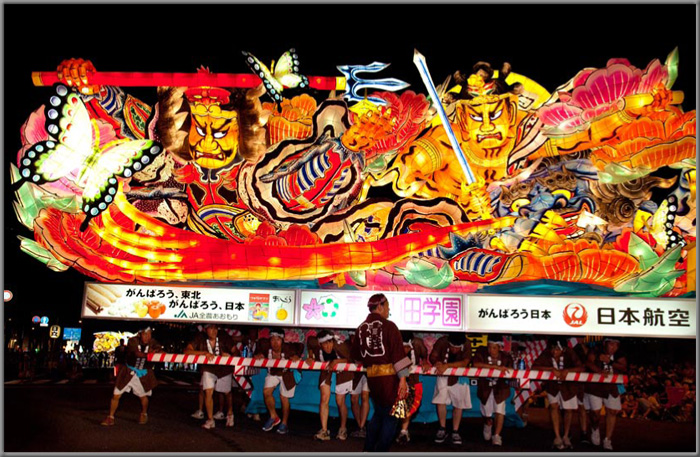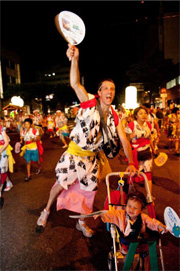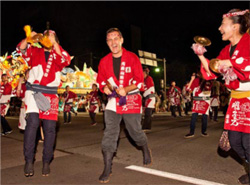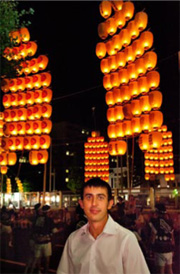Home > Highlighting JAPAN > Highlighting Japan SEPTEMBER 2011 > The Great Summer Festivals of Northern Japan
Highlighting JAPAN
COVER STORY: A Rousing Summer in Tohoku
Caption: The nebuta of Bishamonten (left), god of treasure, wealth and warriors and protector of Buddhism, and Monjubosatsu (right), bodhisattva of wisdom.
Credit: MASATOSHI SAKAMOTO
The Great Summer Festivals of Northern Japan

Luiz Renato Ogasawara, wearing a haneto outfit, waves a paper fan with his child.
Credit: MASATOSHI SAKAMOTO
Aomori Nebuta Festival
"Rasseira! Rasseira!"
The street is full of prancing dancers called haneto, leaping around as they shout. The town is full of excitement, reverberating with the sounds of gongs and drums. Among all this, giant nebuta move slowly along.
The Date Bushoutai, based locally in Sendai, Miyagi Prefecture, was formed last year to promote tourism in Sendai. The team comprises eleven members, including Date Masamune, the warlord who ruled over present-day Sendai, Miyagi, Iwate and Fukushima Prefectures 400 years ago, and Hasekura Tsunenaga, a vassal of Date Masamune who sailed to Europe by crossing the Atlantic Ocean, being the first Japanese to do so. Its martial arts display performance with members dressed in the clothing and armor of the Warring States period, is very popular.
The Aomori Nebuta Festival was held this year from August 2 to 7 in Aomori City, Aomori Prefecture. It is the most heavily attended of all the summer festivals in Tohoku. This year, as well, Aomori City was filled with around 2.6 million tourists, nearly ten times the city's population.
Nebuta are paper statues made in the likeness of kabuki actors or historical figures, imaginary animals or gods. They are illuminated from the inside by between 600 and 800 electric bulbs and fluorescent lights. The largest are 9 m wide, 5 m tall and 7 m deep. At the Aomori Nebuta Festival, the forty colorful nebuta are each loaded onto carts and pushed around the city by hand.
Anyone wearing a haneto outfit can participate in the Nebuta Festival. Every year, many foreigners also participate, including members of the U.S. military and their families from Misawa Air Base in Misawa City, Aomori Prefecture. The Aomori International Volunteer Association even invites foreigners to be haneto, lends them haneto outfits and helps them put them on.
"Nebuta is a lot like Carnival in Rio!" says Brazilian Luiz Renato Ogasawara. "At the Rio Carnival there are also giant floats and tons of people dancing around like crazy."
Ogasawara married a Japanese woman four years ago, and currently lives in Aomori City. Since he works as a dance instructor, dancing comes naturally to him.
"When I dance in the Nebuta Festival, I feel as if I've returned to the town where I was born," says Ogasawara.

Santiago Salinas (center) strikes a gong as he dances.
Credit: MASATOSHI SAKAMOTO
"By chance, ten years ago I saw a nebuta at an exhibition in Tokyo. I was fascinated by the powerful shape and beautiful colors," says Salinas. "I was also really surprised to find that nebuta are made out of only wire and paper."
Since then Salinas has often visited Aomori to study the culture of nebuta, including the history, the way they're made and their shape. He's currently writing a thesis about nebuta.
"Since the Great East Japan Earthquake struck this year, my friends and family were against me visiting Japan," says Salinas. "But since my friends in Aomori told me that there wasn't any damage here, even though it's in the Tohoku region, I wasn't worried at all. Now all I want to do is say to Tohoku, 'Keppare!'" (an expression in the Tohoku dialect which means, "You can do it!").

When Sobolev Vadim was in high school, he spent a year studying at a high school in Miyazaki Prefecture as a Rotary Club exchange student. "At that time my image of Japan was samurai and sushi. I couldn't speak Japanese at all," Vadim says. After returning home, he studied Japanese at university in Russia, and from 2008 spent a year studying at Tohoku University. He became an Akita Prefecture Coordinator for International Relations in August 2010. "Akita is abundant in nature, the people are king and it's an easy place to live. Even the rent's cheaper than in Vladivostok."
Credit: MASATOSHI SAKAMOTO
The Kanto Festival
"Dokkoisho!"
The spectators along the route give loud shouts of encouragement.
While the music of drums, Japanese flutes and gongs plays, performers called "sashite" turn tricks with the 12-m-long bamboo poles called "kanto" which they carry, these being hung with forty-six candle-lit paper lanterns. The sashite balance the kanto, which way upwards of 50 kg, on their back, shoulders and even their forehead. The bamboo pole bends deeply, swaying the kanto wildly and sending a thrill through the spectators.
The Kanto Festival, whose origins are in the Edo period (1603–1867), was held from August 3 to 6 in Akita City, Akita Prefecture. Teams are formed by workplace or neighborhood friends. Each team performs its amazing feats in the streets of the city. There are more than 250 kanto. Every year many tourists come to watch. This year as well the route was packed with around 1.3 million people.

The Kanto Festival has its origins as a form of prayer for a rich harvest. The lanterns which hang from the kanto represent straw bags of rice. The performer standing in the foreground, center, is balancing a kanto on his forehead.
Credit: MASATOSHI SAKAMOTO
Vadim, from Vladivostok, Russia, started working at the Akita Prefectural Office as a Coordinator for International Relations one year ago. As part of his job he interprets, translates and promotes international understanding such as by holding lectures at schools in Akita Prefecture.
When the Great East Japan Earthquake struck in March, he was working in Akita City. "I couldn't call my family or girlfriend living in Vladivostok. When I was finally able to reach them quite a while after the earthquake, I explained that everything was perfectly fine in Akita, and they shouldn't be worried. But they told me to go back as soon as possible. In Russia the media made it sound like all of Japan was damaged by the quake," says Vadim. "Because of reports like that, for a while there was a drop in visitors to Akita from Russia. But now it's back to normal."
In 2010 Akita Prefecture concluded a comprehensive friendship pact with Primorsky Krai (the region of which Vladivostok is the administrative center). Akita Prefecture and Vladivostok lie just on opposite shores of the Sea of Japan. Making the most of this geographical proximity, Akita Prefecture and Primorsky Krai aim to strengthen their ties through international distribution and agricultural and medical fields.
"Almost all the cars in Vladivostok were imported from Japan. Sushi is also really popular there now," says Vadim. "In the future I'd like to establish a business that can benefit both Akita and Vladivostok."
© 2009 Cabinet Office, Government of Japan






